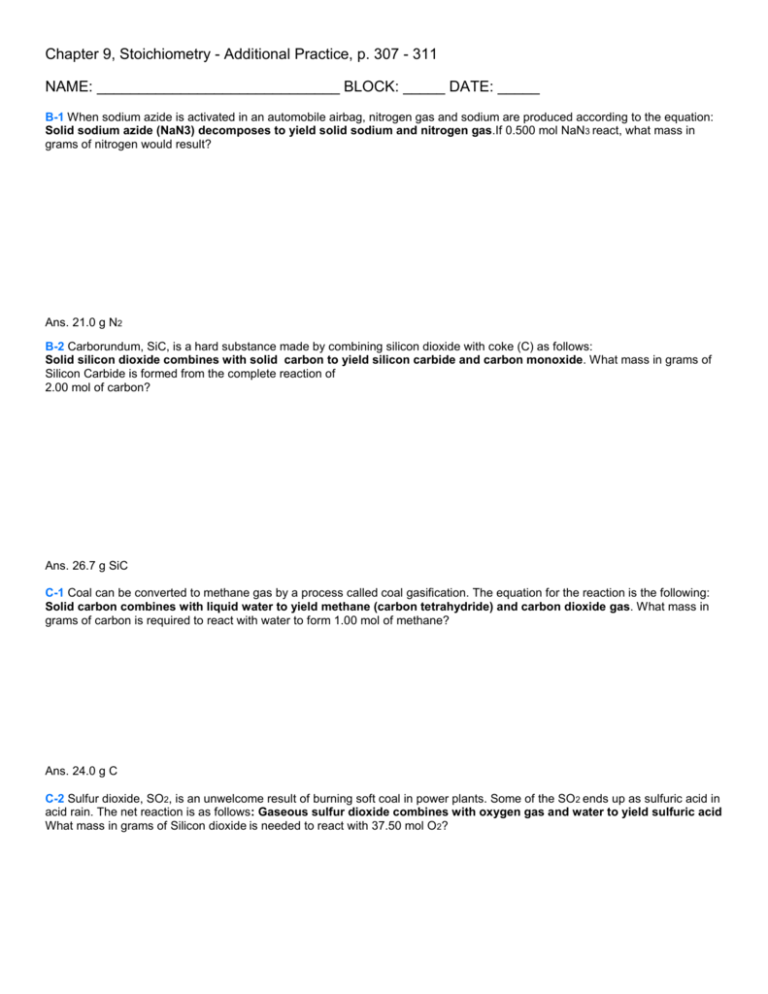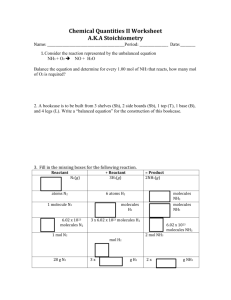Chapter 9, Stoichiometry - Additional Practice, p. 307
advertisement

Chapter 9, Stoichiometry - Additional Practice, p. 307 - 311 NAME: _____________________________ BLOCK: _____ DATE: _____ B-1 When sodium azide is activated in an automobile airbag, nitrogen gas and sodium are produced according to the equation: Solid sodium azide (NaN3) decomposes to yield solid sodium and nitrogen gas.If 0.500 mol NaN3 react, what mass in grams of nitrogen would result? Ans. 21.0 g N2 B-2 Carborundum, SiC, is a hard substance made by combining silicon dioxide with coke (C) as follows: Solid silicon dioxide combines with solid carbon to yield silicon carbide and carbon monoxide. What mass in grams of Silicon Carbide is formed from the complete reaction of 2.00 mol of carbon? Ans. 26.7 g SiC C-1 Coal can be converted to methane gas by a process called coal gasification. The equation for the reaction is the following: Solid carbon combines with liquid water to yield methane (carbon tetrahydride) and carbon dioxide gas. What mass in grams of carbon is required to react with water to form 1.00 mol of methane? Ans. 24.0 g C C-2 Sulfur dioxide, SO2, is an unwelcome result of burning soft coal in power plants. Some of the SO2 ends up as sulfuric acid in acid rain. The net reaction is as follows: Gaseous sulfur dioxide combines with oxygen gas and water to yield sulfuric acid What mass in grams of Silicon dioxide is needed to react with 37.50 mol O2? Ans. 4805 g SO2 (Continue next page) More Practice, p. 309 D-1 Chlorine gas can be produced commercially by passing an electric current through a concentrated solution of sodium chloride (brine). The equation is as follows:Aqueous sodium chloride combines with water to yield aqueous sodium hydroxide, chlorine gas and hydrogen gas. a. If the brine contains 250 g NaCl, how many moles of Cl2 can be produced? b. How many moles of H2 can be produced? Ans. a. 2.14 mol Cl2 Ans b. 2.14 mol H2 D-2 The compound PtCl2(NH3)2 is effective as a treatment for some cancers. It is synthesized by the reaction shown in the following equation. K2PtCl4(aq) 2NH3(aq) 2KCl(aq) PtCl2(NH3)2(aq) a. How many moles of K2PtCl4 must react in order to produce 30.0 g PtCl2(NH3)2? b. How many moles of NH3 are needed to produce 30.0 g PtCl2(NH3)2? Ans. a. 0.100 mol K2PtCl4 b.0.200 mol NH3 E-1 Sodium peroxide reacts with water in the following unbalanced equation: Na2O2(s) H2O(l ) NaOH(aq) O2(g) a. What mass of O2 is produced when 50.0 g Na2O2 react with H2O? b. What mass in grams of water is needed to react completely with the Na2O2? Ans. a. 10.3 g O2 b. 11.6 g H2O






